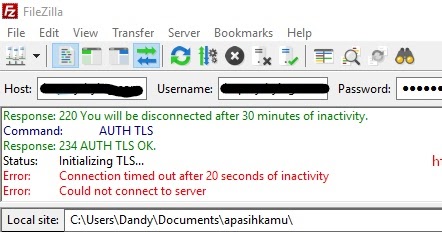

Then follow the steps as per the message, you may be asked to enter the passwords again, enter it. Users can attempt to correct ETIMEDOUT errors by adjusting the 'Timeout' threshold in FileZillas settings, accessible by selecting the 'Settings' option from the Edit menu and locating the 'Timeout' section.On the General tab, in the Encryption list box, select Only use plain FTP (insecure). To do this, follow these steps: Start FileZilla.
Filezilla connection timed out password#
Then enter host address, user name and password and click the ‘Connect’ button. You can resolve this problem by resetting your accounts to use plain, unencrypted FTP connections. Change the Encryption field to ‘Only use plain FTP (insecure)’ and Logon type to ‘Normal’.In case the issue still persists, follow the below steps: FileZilla has a setting called Timeout that is triggered if no data is sent or received during an operation for longer than the timeout (default 20. You will find the field ‘Timeout in seconds’, which will extend the duration where FileZilla will try to reconnect if any issues arise with connection. Under Selection page on the left-hand side, click on ‘Connection’.In the dashboard, click on ‘Edit’ -> Settings.To solve this problem, you need to uninstall affected firewalls and replace the faulty routers.When you access the server via FTP using Filezilla, it displays connection timeout error, it is the time to change the Filezilla settings for resolving the issue.Ĭheck the below steps to resolve timeout issue: In other words, all routers and firewalls that are dropping idle connections too early cannot be used for long FTP transfers. However, many routers and firewalls drop connections that have been idle for less than 2 hours and 4 minutes. Therefore, with added tolerance for network latency, connections can stay idle for up to 2 hours and 4 minutes. However these keep-alive packets should not be sent more often than once every two hours. In an attempt to solve this problem, the TCP specifications include a way to send keep-alive packets on otherwise idle TCP connections, to tell all involved parties that the connection is still alive and needed. But since the control connection got dropped without notification, the reply never arrives and eventually the connection will timeout. Likewise, the client thinks the control connection is alive and it waits for the reply from the server.

So when all data has been transferred, the server assumes the control connection is alive and it sends the transfer confirmation reply. You can resolve this problem by resetting your accounts to use plain, unencrypted FTP connections. For FTP, this means that during a long transfer the control connection can get dropped because it is detected as idle, but neither client nor server are notified. However, many routers and firewalls automatically close idle connections after a certain period of time. Unless explicitly closed, a connection is supposed to remain alive indefinitely. The TCP specifications do not set a limit on the amount of time a connection can stay idle.

It is the nature of FTP that during a transfer the control connection stays completely idle. This used to work, but now when I try to connect via FileZilla to FTP, I get a connection timeout. If you can transfer small files without any issues, but transfers of larger files end with a timeout, a broken router and/or firewall may exist between the client and the server and is causing a problem.įTP uses two TCP connections: a control connection to submit commands and receive replies, and a data connection for actual file transfers.


 0 kommentar(er)
0 kommentar(er)
